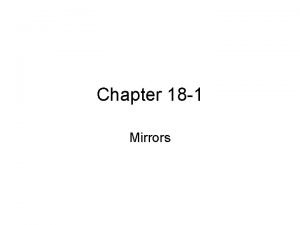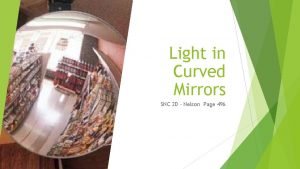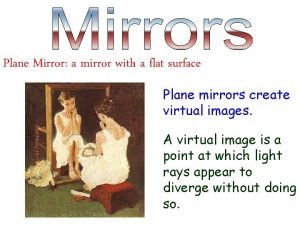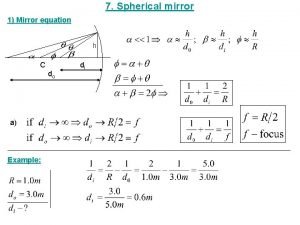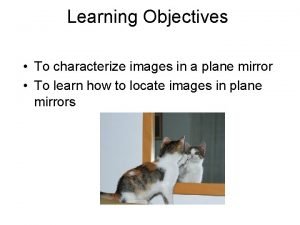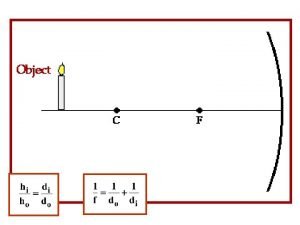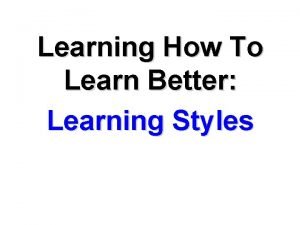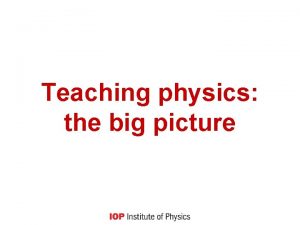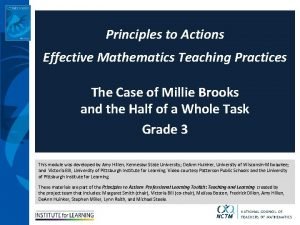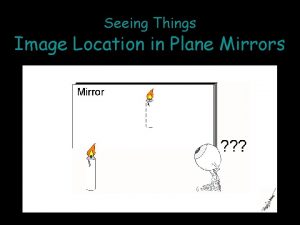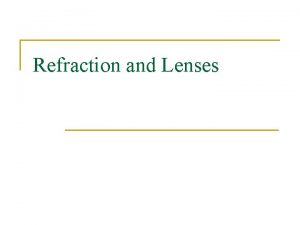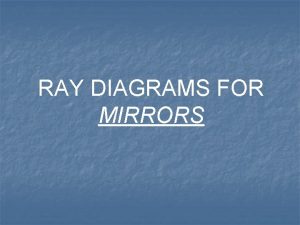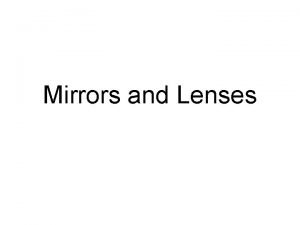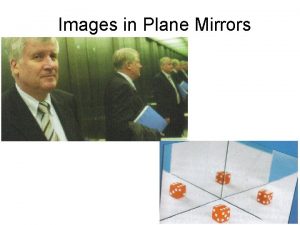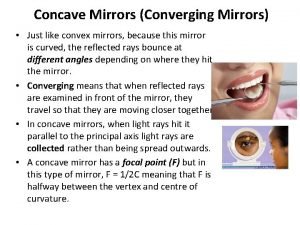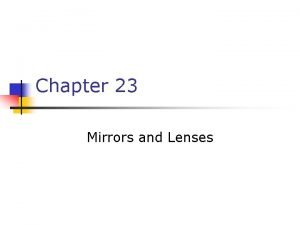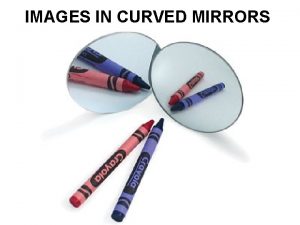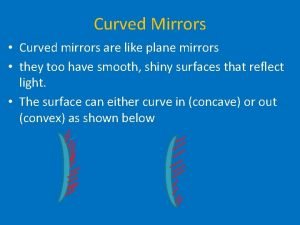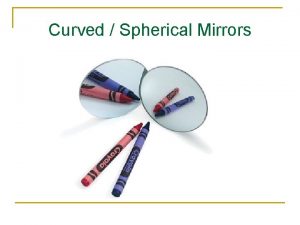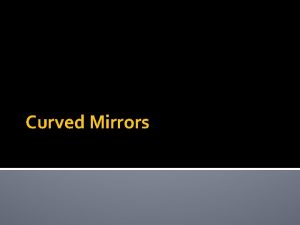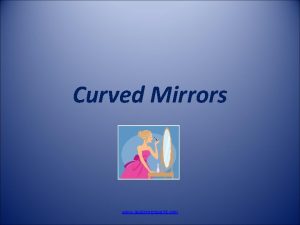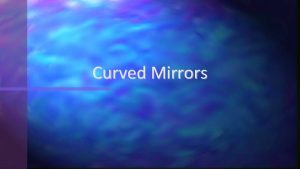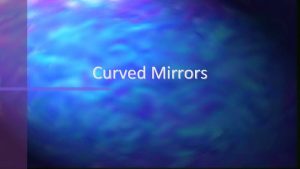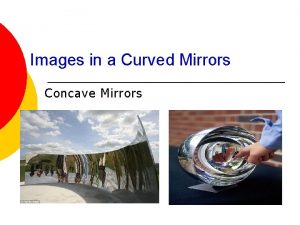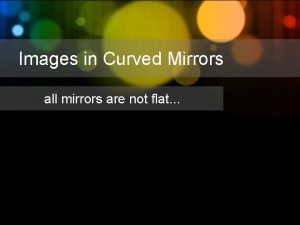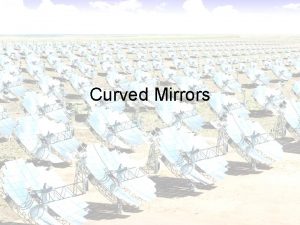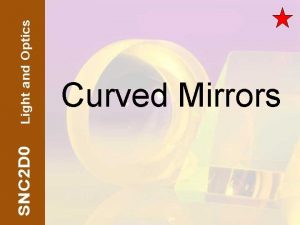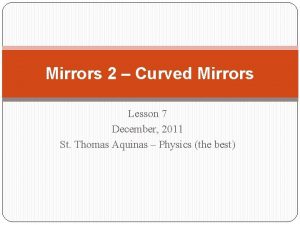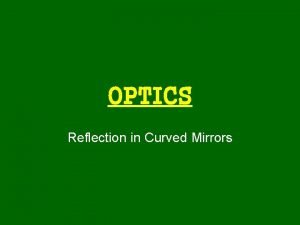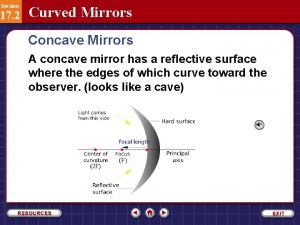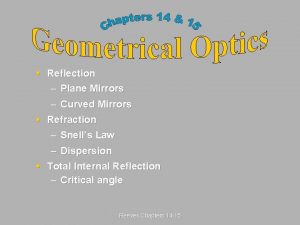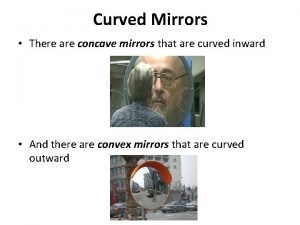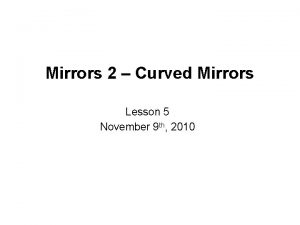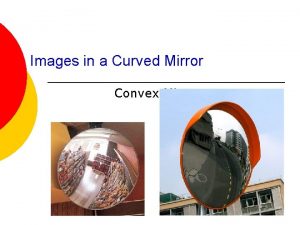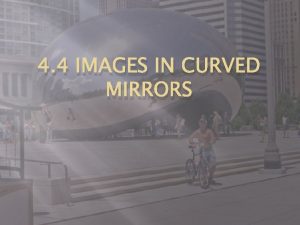Images in Curved Mirrors Learning Goals To learn

































- Slides: 33

Images in Curved Mirrors

Learning Goals To learn more about the differences between concave and convex mirrors To learn how to predict and locate images in concave and convex mirrors

Introduction Curved mirrors are created when you make part of the surface of a sphere reflective If the reflection is from the inner surface of the sphere, the mirror is concave. The centre of a concave mirror bulges away from you

Introduction In a convex mirror, the reflection is from the outer surface of the sphere The centre of a convex mirror bulges



Terminology The centre of curvature of a mirror is the centre of the sphere, part of whose surface forms the curved mirror It is labelled as C

Terminology The principal axis of the mirror is the line going through the centre of curvature and the centre of the mirror

Terminology Because the principal axis goes through the centre of the circle, this axis is a radius of the circle This means that the principal axis intersects the mirror at 90° and is normal to the surface The vertex is the point where the principal axis intersects the mirror It is labelled as V

Terminology Any light rays that are parallel to the principal axis will be reflected off the mirror through a single point This point is where all the parallel light rays come together, or “converge” is called the focus It is labelled as “F” Because a concave mirror focuses parallel rays at F, this type of mirror is also called a converging mirror

Terminology

How to Locate the Image in a Converging (Concave) Mirror

Images in a Concave Mirror To determine the image of an object in front of a concave mirror, you need to draw at least two incident rays from the top of the object These rays will be reflected off the mirror and may or may not cross to form an image.

https: //www. youtube. com/watch? v=xz. VSp. Ymh. Ctk Images in a Concave Mirror


Images in a Converging Mirror If you place a luminous source at a distance greater than C, you can locate an image of this source by moving a paper screen back and forth in front of the mirror

Images in a Converging Mirror The image is smaller, inverted, and somewhere between C and F In this case, light is actually arriving at the image location This type of image is called a real image Any image that can be formed on a screen is a real image because light rays are actually arriving at the image location

Images in a Converging Mirror When an object is: Ø Beyond C (example a) Ø At C (example b) Ø Between C and F (example c) The reflected rays actually meet in front of the mirror, forming an inverted, real image each time Many devices make use of the properties of concave mirrors


Images in a Converging Mirror In a searchlight, the light source (the filament) is at the focus, and the reflected rays form a parallel beam

Images in a Converging Mirror No real image is produced when an object is located at F in front of a concave mirror The reflected rays are parallel and do not intersect to form an image If you extend the rays behind the mirror using dashed lines, you cannot even see a virtual image

Images in a Converging Mirror No real image is produced when an object is between F and the concave mirror The reflected rays spread apart, or diverge

Images in a Converging Mirror The human brain, interprets these diverging rays backwards to where they appear to originate, which in this case is behind the mirror This results in a virtual image because the concave mirror is opaque These extrapolated rays cannot actually come from behind the mirror

Images in a Converging Mirror A virtual image behind a concave mirror is always larger and upright A shaving mirror and a makeup mirror are two common examples that make use of this property

Summary

How to Locate the Image in a Diverging (Convex) Mirror

Images in a Convex Mirror The parts of a convex mirror and the imaging rules for a convex mirror are similar to those for a concave mirror

Images in a Convex Mirror The difference is that: 1. F is now called a virtual focus 2. C and F are behind the mirror 3. Light rays seem to come from an apparent light source behind the mirror

Images in a Convex Mirror

Images in a Convex Mirror The rays reflected off a convex mirror always diverge Diverge means to spread out For this reason, a convex mirror is also called a Diverging Mirror Reflected rays from an object never cross in front of the mirror to form a real image The human brain interprets these rays as being behind the mirror to where they appear to converge.

https: //www. youtube. com/watch? v=CA 4 fe 9 Za 4 ok Images in a Convex Mirror This results in the diverging (convex) mirror producing a smaller, upright, virtual image. This property makes convex mirrors very useful as security mirrors in stores

Images in a Convex Mirror

Images in a Convex Mirror Convex mirrors show a wide range of view with their smaller virtual image Convex mirrors are also used as the side-view mirror on vehicles “Objects in mirror are closer than they appear” is frequently printed at the bottom of side-view mirrors to remind viewers that they are seeing a smaller image
 Spherical aberration in mirrors
Spherical aberration in mirrors Mirror salt
Mirror salt Strategic goals tactical goals operational goals
Strategic goals tactical goals operational goals Strategic goals tactical goals operational goals
Strategic goals tactical goals operational goals Plane mirror
Plane mirror Single concave spherical mirrors produce images that
Single concave spherical mirrors produce images that All images in plane mirrors are apex
All images in plane mirrors are apex Kinesthetic learning
Kinesthetic learning General goals and specific goals
General goals and specific goals Examples of generic goals and product-specific goals
Examples of generic goals and product-specific goals Cuadro comparativo de e-learning
Cuadro comparativo de e-learning Virtual and real images
Virtual and real images Hi
Hi Mail @ malaysia.images.search.yahoo.com
Mail @ malaysia.images.search.yahoo.com How to save images on google images
How to save images on google images Yahoo.com.yw
Yahoo.com.yw Learning to learn
Learning to learn Learning how to learn
Learning how to learn Big picture learning goals
Big picture learning goals Amt learning goals
Amt learning goals A repetition of or return to criminal behavior.
A repetition of or return to criminal behavior. Establish mathematics goals to focus learning
Establish mathematics goals to focus learning Example of learning objectives
Example of learning objectives Ipc personal goals
Ipc personal goals Chapter 2 learning goals outline sociology answers
Chapter 2 learning goals outline sociology answers Flat plate collector with adjustable mirrors
Flat plate collector with adjustable mirrors Plane mirror location
Plane mirror location Refraction by a lens
Refraction by a lens Chapter 17 reflection and mirrors
Chapter 17 reflection and mirrors Image formed by plane mirror
Image formed by plane mirror Mirrors and lenses
Mirrors and lenses Optics salt acronym
Optics salt acronym Salt for convex mirrors
Salt for convex mirrors Mirrors and lenses
Mirrors and lenses
